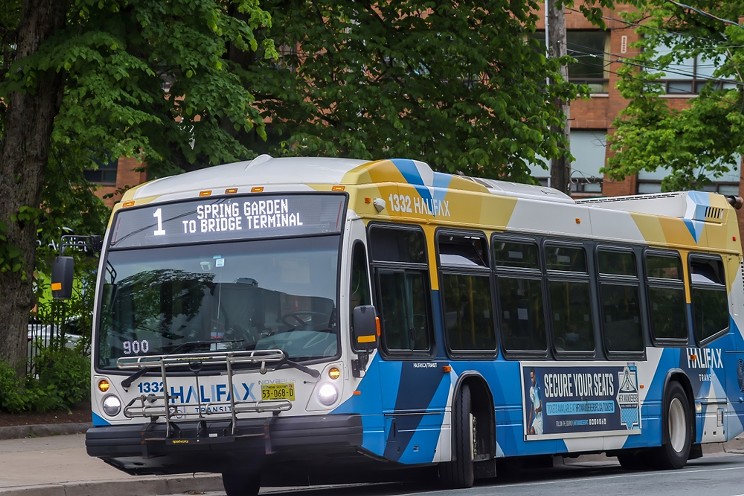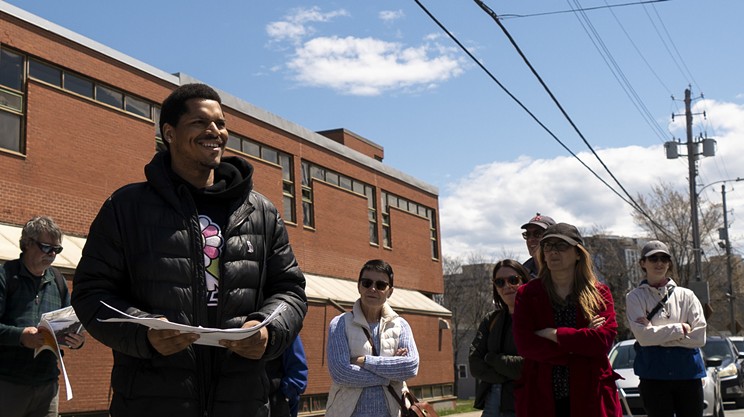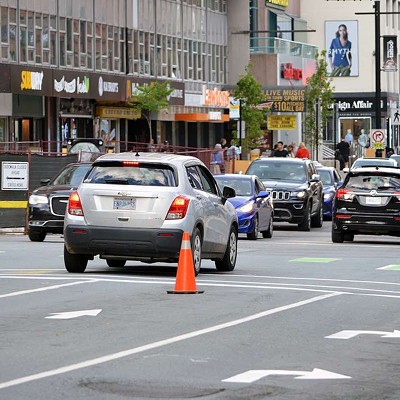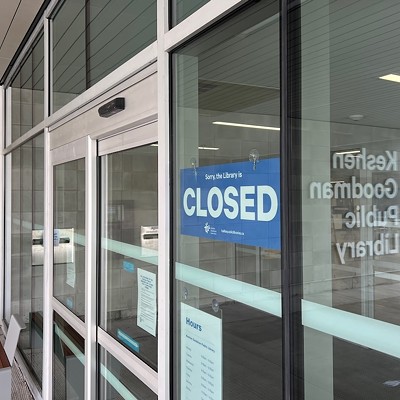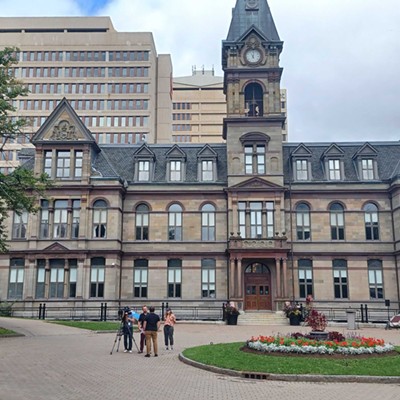Discussions about transportation dominated this week’s regular meeting of Halifax Regional Council, Tuesday Sep. 3. There was some bad, which will be covered in the Notable Debates section below, but there was also the foreshadowing of a better world.
It all started when councillor Trish Purdy pulled an item off the consent agenda, a list of straightforward items that council can vote on all at once . The federal government has a pool of money to bolster cities’ public transit infrastructure, and on the consent agenda was Halifax’s plan to apply for $890 million to replace buses and upgrade transit terminals and generally improve Halifax Transit for the future. Purdy wanted to debate this separately, because she was worried that council was approving almost a billion dollars in spending on the consent agenda.
Multiple city staffers, the CAO and mayor Mike Savage all then explained to Purdy that (as the report explains) this is only council giving permission to the bureaucracy to start the application process for federal money. They also explained that the $890 million is money the city will have to spend anyway as the existing transit infrastructure and buses must be replaced. This federal funding, if successfully secured, will help ease Halifax Transit’s long-term maintenance and replacement budget pressures.
After the impromptu How Council Works 101 course was done, other councillors started asking much better questions, and suddenly, right there in council chambers, the vision for Nova Scotia’s transportation future started to take shape.
Councillor David Hendsbee asked whether or not this funding application would include rural transit options. David Reage, formerly the executive director of Halifax Transit and now the city’s executive director of strategic infrastructure and transportation planning, told Hendsbee that federal money wouldn’t really be used for rural transit specifically. But instead of leaving it at rural areas getting the short end of the transit stick yet again, Reage went on to tell council about the provincial government’s plans. Where the feds are funding current transit infrastructure, the province, through the Joint Regional Transportation Authority, is planning to add new transit options for rural HRM and a one-hour “commuter shed” outside of the HRM. This means in the near future it should be easier to get from Halifax to Kentville, Bridgewater or Truro without a car.
Councillor Kathryn Morse asked Reage if this new money was going to be used on improvements or just replacements. Reage told councillors that the federal money would be mainly for replacements, but he was expecting that in the fall when the JRTA’s plan is announced, the provincial government will finally commit to funding Halifax’s Bus Rapid Transit plan. (Note: Without providing dedicated bus lanes through the HRM’s choke points, the bus transit plan will not be “rapid” in the HRM.)
The JRTA has been developing a holistic transportation plan for months now, and buzz coming out of the provincial political machine is that this plan is both robust and good. In May, the long-time public servant in charge of the JRTA, Mike Peck, told council that his work in the JRTA is making him optimistic about the future. Even the most ardent critics of premier Tim Houston’s Tories are starting to get the sense that in the realm of transportation, this provincial government is taking a long, hard look at the problems with car-centric mass transit and trying to correct them.
The looming spectre of a massive transportation policy win for the sitting Progressive Conservative government is likely why as the council meeting was convening on Tuesday, the Nova Scotia Liberals jumped into the game and announced that if re-elected they’d make transit free. Which at first glance seems like a great idea. Transit fares are a method of cost recovery that allows transit to keep functioning, and having a policy that replaces fares with more predictable provincial funding is usually good in the short term. This policy would also be a benefit because Canadian transit systems like Halifax Transit are in a bit of a death spiral and this would at least slow the spiral if not reverse it.
But a free transit policy exposes cities to a lot of future risk. When municipalities become dependent on provincial funding to operate essential municipal services, if that funding gets pulled in the future it’s very hard for cities to close that funding gap. And as Alberta is learning, it would be very easy for a bad politician to come in and shut down the proposed liberal policy. Nova Scotia Liberal leader Zach Churchill’s policy proposal would keep Halifax Transit afloat in the short term, but also make it quite easy for a malicious or just dumb premier just to pull the funding and flush all provincial transit down the drain.
Things that passed
The Cogswell redevelopment needs more money for the next phase due to soil contamination, but overall, the cost of the project is expected to go down by $9.7 million.
Speaking of Cogswell, also on council’s agenda was a motion to start the process of allowing a community land trust and getting serious about using municipal powers to create affordable housing. This is also the first step in correcting a historic injustice. And ICYMI, The Coast’s Brendyn Creamer wrote about it in May.
Speaking of getting serious about using municipal powers to make housing more affordable, as part of the housing accelerator fund process, the city is also fundamentally rethinking what the suburbs will look like. On top of that, the province has designated a few special planning areas. In order to better incorporate those areas with the suburban plan work, the city is standing up a new temporary community council. In the report, staff say it’s cheaper and easier to stand up a new council rather than jamming this work into the existing community councils. We’ll have to wait and see what happens next as this one was deferred.
The city gave some street names to private roads. Provincial and municipal policy dictates that when a private road or driveway has more than three addresses, the street needs to get a name and the addresses need numbers. This is so that if people living there have a heart attack or a house fire, when they call 911 they can tell emergency responders where the emergency can be found. Councillor Pam Lovelace weighed into this debate to say there was a policy gap because the HRM isn’t paying for private roads so they shouldn’t have names because the city isn’t doing maintenance on private roads. It’s still not clear what policy gap exists, if any, as emergency responders will still need to know where you are to get to you in an emergency even if the roads aren’t maintained.
As covered in the intro, the HRM will apply for some federal money to buy more electric buses and generally invest in better transit infrastructure.
City staff are recommending that council not approve giving money to the province to build an active transit connection between Lower Sackville and Burnside. In the report, staff write that the province wants to put the AT lane next to the highway, and it will now cost $5-$9 million instead of the expected $1 million. Staff are instead recommending building this lane next to trunk 7, aka Magazine Hill, for $3 million in 2030. Staff are recommending this even though they also write that this plan could be blown up because the city still needs to survey the land and ensure there are no explosives from the military’s rifle range next door on the planned AT route. Look for improvements to Magazine Hill in 2030 because this passed.
Council got an update on last year’s municipal finances. The city had a bit of a surplus, but since the city can’t have a deficit or a surplus, they moved the extra money into some capital funding reserves and replenished the “operating stabilization reserve,” which is the money used after emergencies like the upper Tantallon Wildfire.
Council approved the less-than-market-value lease for the YWCA. This will allow a daycare in Beaver Bank to continue operating under the YWCA’s banner.
Councillor Morse asked for a staff report to reconnect Briarwood Crescent and Bayview Road.
Councillors Tim Outhit and Lovelace are teamed up to ask for a pump track to be installed in Brookline Drive Park. Nothing says good governance quite like putting a bike track for kids at a park people have to drive to. There’s a popular meme in political circles that goes a little something like this.
During this debate, councillor Lovelace framed this as the city doing some good. She explained that it was good that this municipal project was finally moving ahead since the kids who first pushed for this amenity are now adults with kids of their own. Installing this pump track is only a feel-good story if you don’t think about the fact that it took the city a few decades to install a cheap strip of asphalt in a park.
And council did some in-camera stuff too. Property matters, intergovernmental relations and labour relations and contract negotiations.
Notable Debates
It is always frustrating when councillors talk about scooters and how they are used in the HRM. The issue with scooters is the same as it is with any private personal vehicle: People will do whatever they want because it’s impossible for the city to police human behaviour on the scale required to make personal transportation vehicles societally safe.
Councillors had a lot of questions and concerns like what happens if vehicles are parked haphazardly blocking sidewalks and bike lanes? Do we track injuries caused by scooters? What if scooters hit pedestrians? What powers does council have to prevent the nuisance and menace posed by vehicles!?
And to be clear, the issue here is not that scooter riders don’t cause issues, it’s that other private vehicle operators, namely drivers of faster and heavier automobiles, cause all the same issues with far greater consequences. But when it comes to scooter riders, councillors hone in on what powers they have and what they can do to mitigate the known issues and dangers of micro mobility. When it comes to car drivers, councillors are more than happy to let the fatal status quo continue on unchecked, happy to let their power go unused, resulting in catastrophic violence to HRM’s residents. Although we don’t actually know how much violence, since the HRM’s road safety dashboard only posts injuries that make it into police reports, automobile violence is also under reported.
It would be nice to see a council aware of this double standard and working to correct it. After four years of the same it's unlikely to come from this current crop of councillors, so we’ll have to vote better in October.

